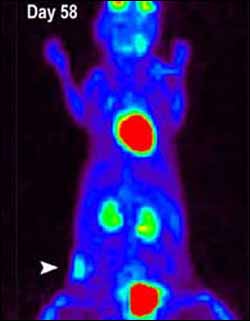Small Animal Imaging Gives Cancer Clues

PET imaging shows a breast cancer-like growth in a mouse. (Craig Abbey/UC Davis photo)
Advances in biomedical imaging are allowing UC Davis researchers to use mice more effectively to study cancers comparable to human disease. The system can distinguish different stages of cancer and could lead to more sensitive screening tests for cancer-fighting drugs.
Positron emission tomography (PET) is widely used for detecting and following cancer in human patients. It works by following short-lived radioactive tracers that are taken up by fast-growing cancer cells.
PET scanners used for humans don’t have the resolution to image an animal as small as a mouse. Researchers led by Simon Cherry, a professor of biomedical engineering at UC Davis, have developed a PET scanner sensitive enough to use with mice, and Craig Abbey, also in the Department of Biomedical Engineering, has developed image analysis methods to use the scanner to monitor tumors.
They’re working with cancer researchers Alexander Borowsky, Robert Cardiff and Jeffrey Gregg at the UC Davis Center for Comparative Medicine to study cancerous growths in mice similar to ductal carcinoma in situ (DCIS), a precursor to breast cancer in humans.
“With non-invasive imaging, we can follow the development of disease in one mouse over a long time period,” Abbey said. The method is also more sensitive to changes in cancer growth, making it possible to look for small treatment effects.
Most invasive breast cancers are thought to develop from DCIS, and standard care is to remove the entire area involved, Borowsky said. Based on the appearance of a DCIS under the microscope, doctors can estimate how quickly it could become a more aggressive, invasive form if not completely removed, he said. The new PET technology allows researchers to follow the same changes in a mouse without surgery.
“Not only can we see the DCIS-like lesion, but we can detect the earliest transition to an invasive tumor,” Borowsky said. The model could be used to test treatments that would slow or stop that transition in human patients, as well as to ask basic questions about how cancers develop.
The work was published July 26 in Proceedings of the National Academy of Sciences of the USA online.
Media Contact
More Information:
http://www.ucdavis.eduAll latest news from the category: Life Sciences and Chemistry
Articles and reports from the Life Sciences and chemistry area deal with applied and basic research into modern biology, chemistry and human medicine.
Valuable information can be found on a range of life sciences fields including bacteriology, biochemistry, bionics, bioinformatics, biophysics, biotechnology, genetics, geobotany, human biology, marine biology, microbiology, molecular biology, cellular biology, zoology, bioinorganic chemistry, microchemistry and environmental chemistry.
Newest articles

A universal framework for spatial biology
SpatialData is a freely accessible tool to unify and integrate data from different omics technologies accounting for spatial information, which can provide holistic insights into health and disease. Biological processes…

How complex biological processes arise
A $20 million grant from the U.S. National Science Foundation (NSF) will support the establishment and operation of the National Synthesis Center for Emergence in the Molecular and Cellular Sciences (NCEMS) at…

Airborne single-photon lidar system achieves high-resolution 3D imaging
Compact, low-power system opens doors for photon-efficient drone and satellite-based environmental monitoring and mapping. Researchers have developed a compact and lightweight single-photon airborne lidar system that can acquire high-resolution 3D…





















